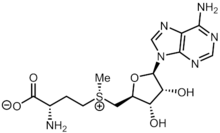
| |
| Names | |
|---|---|
| IUPAC name 5′-S-Methyl-5′-thioadenosine | |
| Systematic IUPAC name (2R,3R,4S,5S)-2-(6-Amino-9H-purin-9-yl)-5-oxolane-3,4-diol | |
Other names
| |
| Identifiers | |
| CAS Number | |
| 3D model (JSmol) | |
| ChEBI | |
| ChemSpider | |
| ECHA InfoCard | 100.154.727 |
| KEGG | |
| PubChem CID | |
| UNII | |
| CompTox Dashboard (EPA) | |
InChI
| |
SMILES
| |
| Properties | |
| Chemical formula | C11H15N5O3S |
| Molar mass | 297.33 g·mol |
| Melting point | 205 °C (401 °F; 478 K) |
| Hazards | |
| Lethal dose or concentration (LD, LC): | |
| LD50 (median dose) | >1000 mg/kg (mouse, oral) |
| Except where otherwise noted, data are given for materials in their standard state (at 25 °C , 100 kPa). Infobox references | |
5′-Methylthioadenosine is S-methyl derivative of the adenosine. It is an intermediate in the methylthioadenosine (MTA) cycle, also known as the methionine salvage pathway that is universal to aerobic life.
Formation

The pervasive cofactor S-adenosyl methionine (SAM) is the precursor to 5′-methylthioadenosine. The sulfonium group in SAM can cleave in three ways, one involves loss of CH2CH2CH(NH3)CO2, generating the title compound.
History
In 1912, an adenine nucleoside was isolated by Hunter et al. from yeast that were grown without phosphorus or sulfur. Later in 1925, that substance was shown by Levene and Sobotkal to be adenylthiomethylpentose.
In 1936, Nakahara et al. did experiments on rats that suggested that vitamin L2 deficiency inhibits the ability of female rats for lactation. In 1942, they identified vitamin L2 to be adenylthiomethylpentose. Later studies by Folley et al (1942) refuted Nakahara's claims and demonstrated that L2 is not necessary for lactation and thus L2 is not considered a vitamin today.
Hecht found in 1937 that the body temperature of rabbits, cats and guinea pigs were lowered by 1 to 2 degrees after he gave them adenylthiomethylpentose at a dose of 0.2 g/kg. Kühn et al. replicated this in guinea pigs in 1941.
References
- Baddiley, J. (1951). "The synthesis of pantothenic acid-2′ and -4′ phosphates as possible degradation products of coenzyme A". Journal of the Chemical Society: 1348–1351. doi:10.1039/JR9510000246.
- JP application H0446124A, Shimohashi, Hirotaka & Ishihara, Kazuoki, "Antiulcer agent", published 1992-02-17, assigned to Advance Co. Ltd.
- Sekowska, A; Ashida, H; Danchin, A (January 2019). "Revisiting the methionine salvage pathway and its paralogues". Microbial Biotechnology. 12 (1): 77–97. doi:10.1111/1751-7915.13324. PMC 6302742. PMID 30306718.
- Parveen, Nikhat; Cornell, Kenneth A. (2011). "Methylthioadenosine/S-adenosylhomocysteine nucleosidase, a critical enzyme for bacterial metabolism". Molecular Microbiology. 79 (1): 7–20. doi:10.1111/j.1365-2958.2010.07455.x. PMC 3057356. PMID 21166890.
- J. A. Mandel u. E. K. Dunham (1912). "Preliminary note on a purine-hexose compound". J. Biol. Chem. 11: 85–86. doi:10.1016/S0021-9258(18)88777-4.
- P. A. Levene u. H. Sobotka (1925). "The thio-sugar from yeast" (PDF). J. Biol. Chem. 65 (2): 551–554. doi:10.1016/S0021-9258(18)84864-5.
- Waro Nakahara; Fumito Inukai; Saburo Ugami (1936). "Factor L2, a Second Dietary Factor for Lactation". Proceedings of the Imperial Academy. 12 (9): 289–291. doi:10.2183/pjab1912.12.289.
- Waro Nakahara; Fumito Inukai; Saburo Ugami (1942). "Adenylthiomethylpentose as a Form of Vitamin L2". Proceedings of the Imperial Academy. 18 (8): 477–478. doi:10.2183/pjab1912.18.477.
- S. J. Folley; K. M. Henry; S. K. Kon (1942). "Lactation and Reproduction on Highly Purified Diets". Nature. 150 (3802): 318. Bibcode:1942Natur.150Q.318F. doi:10.1038/150318a0.
- R. Kuhn u. K. Henkel (1941). "Über die Senkung der Körpertemperatur durch Adenylthiomethylpentose". Biological Chemistry. 269 (1): 41–46. doi:10.1515/bchm2.1941.269.1.41.
Further reading
- Satoh, Kiyoo; Makino, Katashi (1951). "Structure of adenylthiomethylpentose". Nature. 167 (4241): 238. Bibcode:1951Natur.167..238S. doi:10.1038/167238a0. PMID 14806444. Formerly known as vitamin L2.
- Davidson, Michael W. (2018). "Anthranilic acid (vitamin L)". Formerly known as vitamin L1.